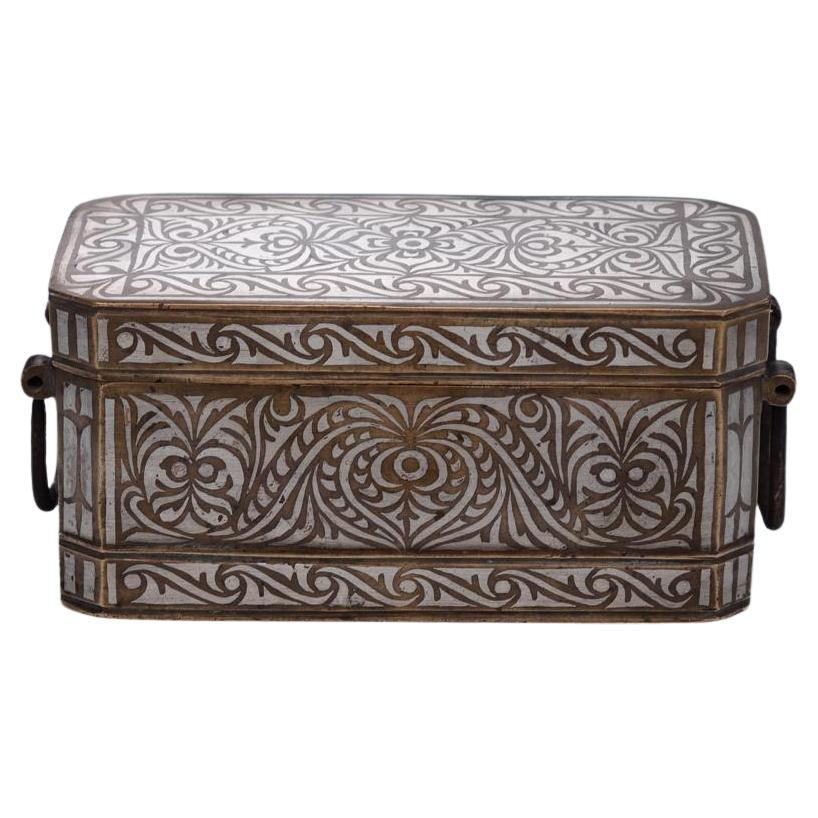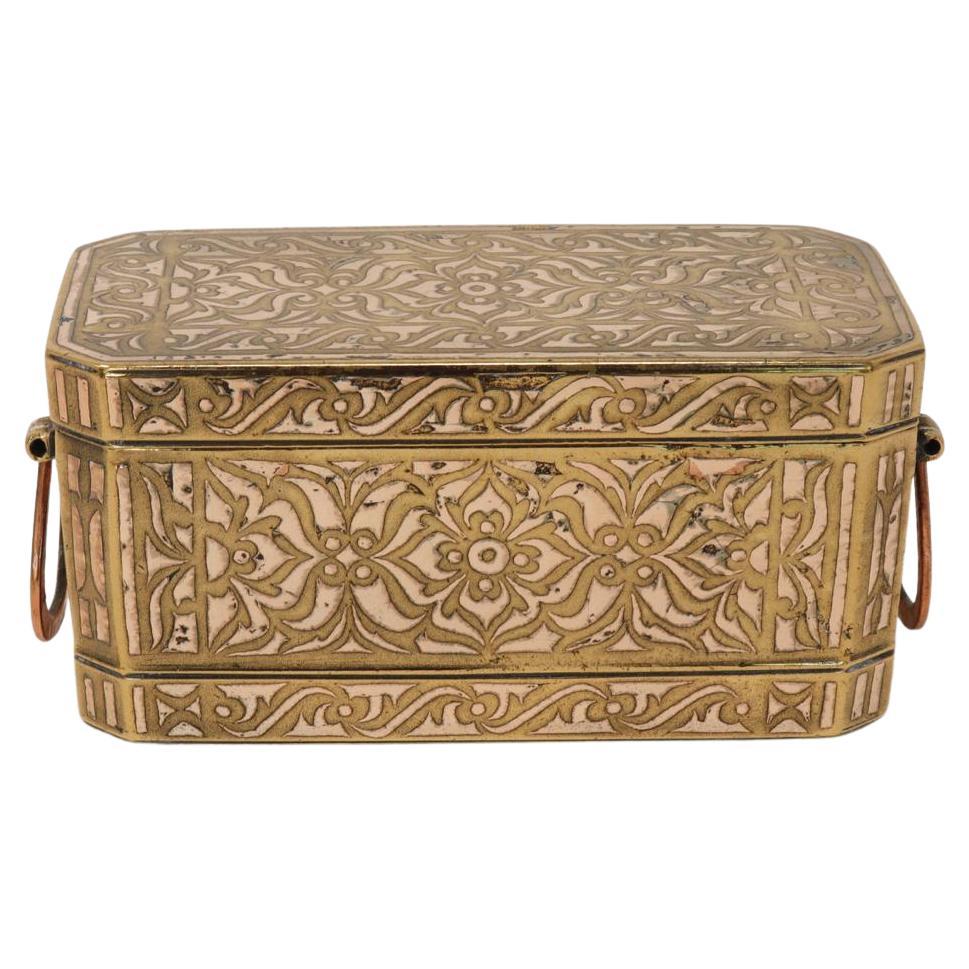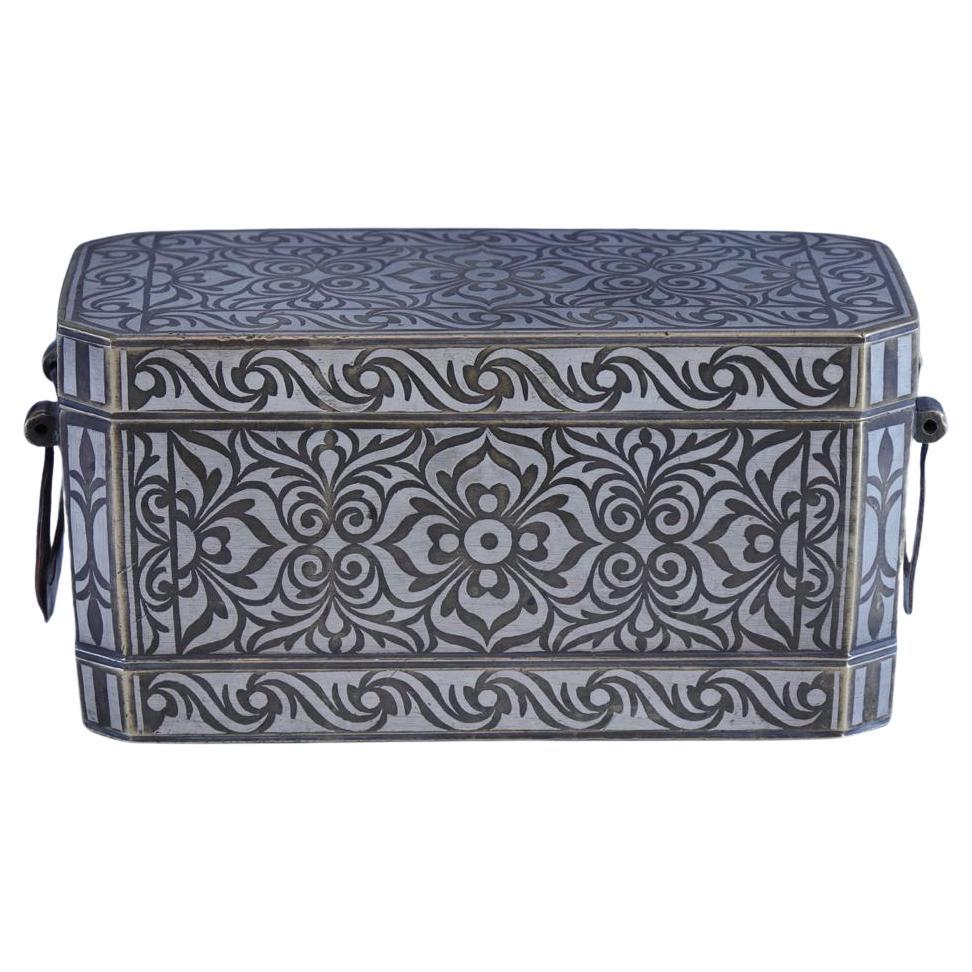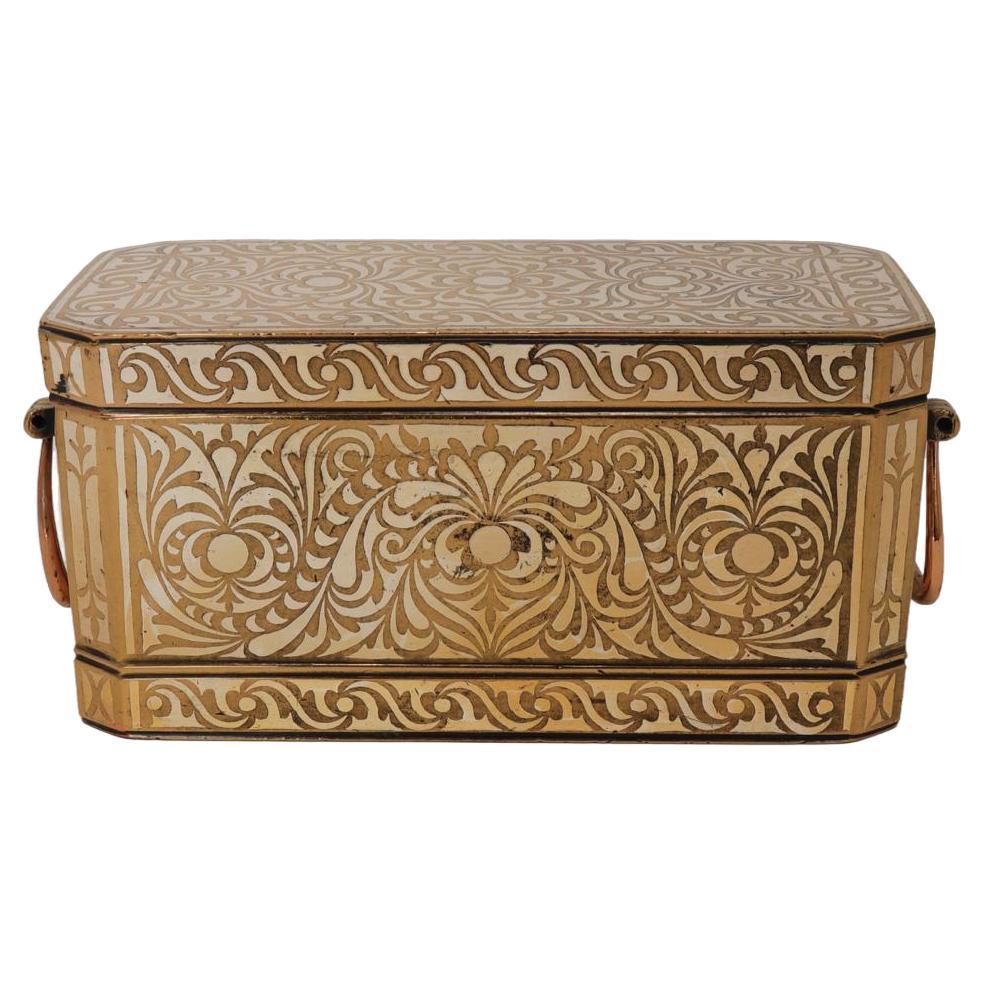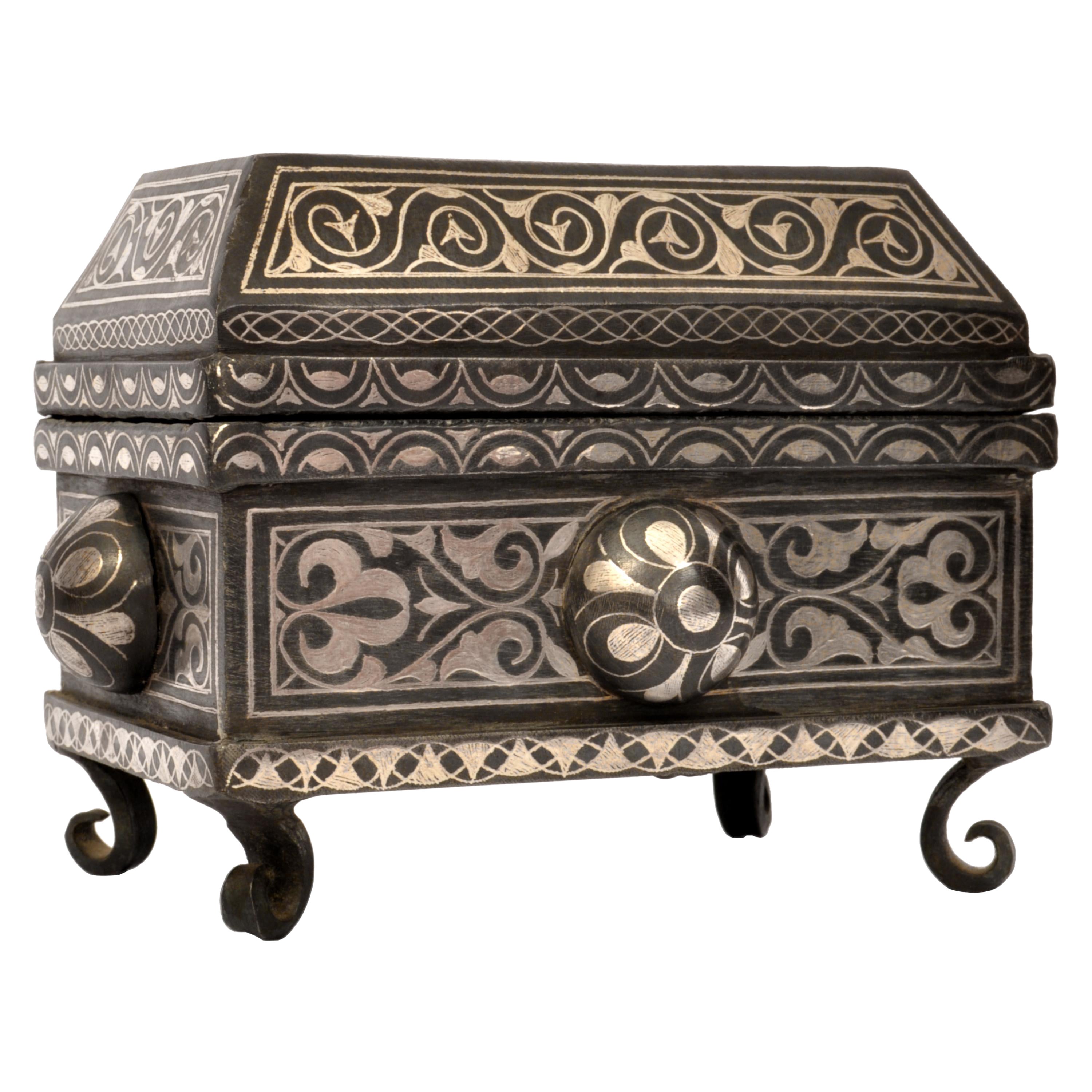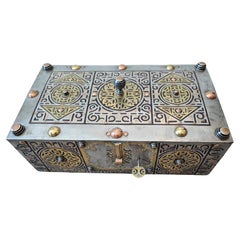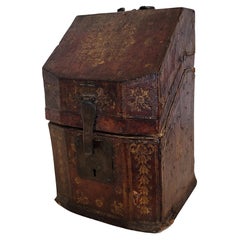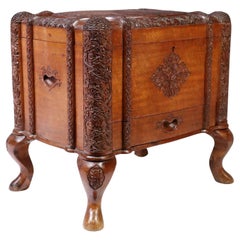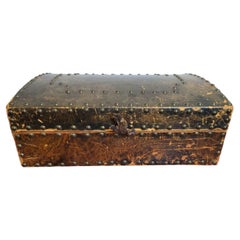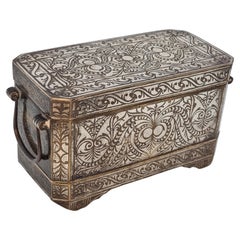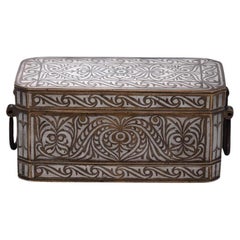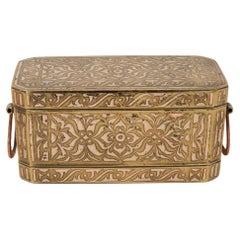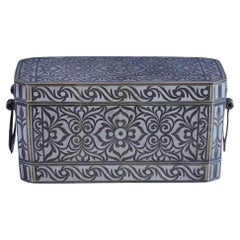Items Similar to Antique Southeast Asian Filipino Maranao Silver Inlaid Brass Betel Nut Box
Want more images or videos?
Request additional images or videos from the seller
1 of 21
Antique Southeast Asian Filipino Maranao Silver Inlaid Brass Betel Nut Box
$1,100
£831.46
€955.50
CA$1,531.74
A$1,704
CHF 893.26
MX$20,822.48
NOK 11,374.54
SEK 10,707.55
DKK 7,132.44
Shipping
Retrieving quote...The 1stDibs Promise:
Authenticity Guarantee,
Money-Back Guarantee,
24-Hour Cancellation
About the Item
A scarce fine quality antique silver-inlaid solid brass betel nut box (Lutuan), dating to the second half of the 19th / early 20th century, hand-crafted in Mindanao, Philippines.
Boxes such as this were used to store the areca nut (also known as the betel nut) which would be wrapped in a betel leaf with lime paste and other ingredients, often tobacco, for chewing. Similar to the European tea caddy, these boxes often served as a way to impress while showing off ones wealth.
Betel chewing was prevalent in the southern Philippines as in much of the rest of Southeast Asia. Wealthier Maranao families on Mindanao were able to afford elaborate silver-inlaid brass betel boxes such as this example. Such boxes were used to show off to guests and from which they were offered betel and the other component such as leaves and lime to make up the betel quid.
Rare large size, most extant examples of such boxes tend to measure around 5 inches in length. At slightly more than 7.75 inches the example here is larger than most.
The distinctive decorative box features a very heavy strong-box like rectangular shaped chest form with canted corners, copper handles, and a conforming hinged lid, lifting open to reveal an interior divided into three compartments covered by four hinged lids. Each of these doors is inlaid with silver in stylized orchid flower patterns.
Exceptionally executed throughout, the arabesque silver inlaid exterior is decorated to the top with a large orchid motif within scrolling obid-obid (stylized rope) borders. The front, back and sides are inlaid with sets of stylized tail feathers of the sari-manok bird beneath which are unusual, highly stylized whimsical zoomorphic faces that appear like cat or tiger faces. (Such stylisation is accounted for by Southeast Asian Islamic preferences to avoid the overt and this potentially idolatrous representation of animal and human forms. Designs such as these are drawn from a local design repertoire that has its origins in wood carving.
Although the spread of Islam in the Philippines began in the 14th century, mostly through the influence of Muslim merchants from the western Malay Archipelago, decorative arts in this design remain exceptionally rare. This lutuan represents a fine example of Islamic metalwork from the most eastern outreach of Islamic art and civilisation: Mindanao island being significantly further east than even China – artwork from Islamic Southeast Asia remains chronically under-represented in the world’s major collections of Islamic art.
PROVENANCE / ACQUISITION
Acquired from highly reputable auction house, Austin Auction Gallery, established 1983, Austin, Texas.
References
Brownrigg, H., Betel Cutters from the Samuel Eilenberg Collection, Thames & Hudson, 1992.
Fraser-Lu, S.,
Silverware of South-East Asia, Oxford University Press, 1989.
Henkel, D.
et al, Land of the Morning: The Philippines and its People, Asian Civilisations Museum, 2009.
Rooney, D.F.,
Betel Chewing Traditions in South-East Asia, Oxford University Press, 1993.
Dimensions:(approx)
3.25" high, 7.75" wide, 3.25" deep
Condition:
It is in fine condition, exquisitely patinated, with highly desirable scattered verdigris teal green patina and oxidation. No observed losses to the silverwork. Evidence of use, including hardened lime used in the assembly of the betel quid remains inside the lidded chambers. Overall, a superb example, museum exhibition quality.
- Dimensions:Height: 3.25 in (8.26 cm)Width: 7.75 in (19.69 cm)Depth: 3.25 in (8.26 cm)
- Style:Islamic (In the Style Of)
- Materials and Techniques:
- Place of Origin:
- Period:
- Date of Manufacture:1860-1910
- Condition:Wear consistent with age and use. Fine condition, heavily patinated, w/highly desirable scattered verdigris and oxidation. No observed losses to the silverwork. Wear consistent with age and indicative of use. Overall a superb example, museum exhibition quality.
- Seller Location:Forney, TX
- Reference Number:1stDibs: LU5977232417342
About the Seller
4.8
Platinum Seller
Premium sellers with a 4.7+ rating and 24-hour response times
Established in 2013
1stDibs seller since 2021
292 sales on 1stDibs
Typical response time: <1 hour
- ShippingRetrieving quote...Shipping from: Forney, TX
- Return Policy
Authenticity Guarantee
In the unlikely event there’s an issue with an item’s authenticity, contact us within 1 year for a full refund. DetailsMoney-Back Guarantee
If your item is not as described, is damaged in transit, or does not arrive, contact us within 7 days for a full refund. Details24-Hour Cancellation
You have a 24-hour grace period in which to reconsider your purchase, with no questions asked.Vetted Professional Sellers
Our world-class sellers must adhere to strict standards for service and quality, maintaining the integrity of our listings.Price-Match Guarantee
If you find that a seller listed the same item for a lower price elsewhere, we’ll match it.Trusted Global Delivery
Our best-in-class carrier network provides specialized shipping options worldwide, including custom delivery.More From This Seller
View AllScarce Antique Tuareg Mauritania North Africa Mixed Metal Mounted Wood Chest
Located in Forney, TX
A rare and magnificent antique Tuareg peoples mixed metal mounted wooden chest / coffer / monumental table box.
Most impressive size, hand-crafted in ...
Category
Early 20th Century Mauritanian Tribal Decorative Boxes
Materials
Brass, Copper, Iron
18th Century Continental Baroque Period Gilt Tooled Leather Clad Knife Box
Located in Forney, TX
A scarce original antique European Baroque Period tooled leather clad cutlery caddy, circa 1740
Handcrafted in Continental Europe in the first half of...
Category
Antique 18th Century European Baroque Knife Boxes
Materials
Leather, Wood
Large Antique South Asian Colonial Carved Camphor Wood Table Box Jewelry Casket
Located in Forney, TX
A scarce antique circa 1900 South Asian hand carved wooden decorative table box / jewel casket.
Hand-crafted in the early 20th century, likely British Ceylon (present day Sri Lanka)...
Category
Early 20th Century South Asian Jewelry Boxes
Materials
Wood
Vintage European Leather Flatware Box Display Chest
Located in Forney, TX
A scarce Continental heavily distressed leather flatware storage box chest, 20th century, finely hand-crafted, rectangular solid wood case, domed ...
Category
20th Century European Decorative Boxes
Materials
Leather, Wood
Large Moorish Arabesque Inlaid Table Box
Located in Forney, TX
A stunning vintage Moorish arabesque inlaid table box, 20th century, high quality rectangular box with hinged lid, featuring contrasting mother of pearl, exotic hardwood, and bone marquetry inlay arranged in geometric patterns, opening to red fabric lined interior.
Dimensions: (approx)
3" High, 16.75" Wide, 6 1/8" Deep; 3.2lbs
As warm and attractive as it is functional, having the ideal large size and proportions for a variety of different uses, including concealing a remote control on your coffee table or sofa table, or as a jewelry casket, trinket case...
Category
20th Century Moorish Decorative Boxes
Materials
Bone, Mother-of-Pearl, Hardwood, Ebony, Rosewood, Tulipwood
Antique Vizagapatam India Table Box Ebonized Wood & Bone Carvings
Located in Forney, TX
Vizagapatam box, India, 19th century.
This highly decorative and unusual Anglo-Indian table box features rustic workmanship that adds to the character and charm of this unique Sout...
Category
Antique 19th Century Indian Anglo Raj Decorative Boxes
Materials
Bone, Wood
You May Also Like
A Mindanao silver inlaid bronze betal nut box, Islamic, mid to late 19th century
Located in Central England, GB
This highly decorative box is a betal nut box. The habit of chewing was relevant in the southern Philippines and much of southeast Asia. Wealthy Maraneo families on the island of Mi...
Category
Antique Late 19th Century Philippine Tribal Decorative Boxes
Materials
Silver
Small Betel Nut Box, Maranao, Southern Philippines (Mindanao)
Located in Point Richmond, CA
Small Betel Nut Box, Maranao, Southern Philippines (Mindanao).
Bronze with bordered silver inlay design overall of a symmetrical floral tendril vine pattern referred to as “the okir ...
Category
Early 20th Century Philippine Tribal Metalwork
Materials
Silver, Bronze
Small Betel Nut Box, Maranao, Southern Philippines (Mindanao)
Located in Point Richmond, CA
Small Betel Nut Box, Maranao, Southern Philippines (Mindanao).
A mixed metal box having a bronze/brass body with bordered silver/copper inlay design overall of a symmetrical floral t...
Category
Early 20th Century Philippine Tribal Metalwork
Materials
Silver, Brass, Copper
Large Betel Nut Box, Maranao, Southern Philippines (Mindanao)
Located in Point Richmond, CA
Large Betel Nut Box, Maranao, Southern Philippines (Mindanao).
Bronze with bordered silver inlay design overall of a symmetrical floral tendril vine pattern referred to as “the okir ...
Category
Antique 19th Century Philippine Tribal Metalwork
Materials
Silver, Bronze
Medium Betel Nut Box, Maranao, Southern Philippines (Mindanao)
Located in Point Richmond, CA
Medium Betel Nut Box, Maranao, Southern Philippines (Mindanao).
Bronze/Brass with bordered silver inlay design overall of a symmetrical floral tendril vine pattern referred to as “th...
Category
Early 20th Century Philippine Tribal Metalwork
Materials
Silver, Brass
Antique 19th Century Indian Bidriware Pandan Silver & Brass Casket Jewelry Box
Located in Portland, OR
Antique early 19th century Indian Bidriware silver and brass Pandan casket, Circa 1800.
Bidriware is credited to the Bahamani Sultans who were the rulers of Bidar in the Northeast part of the state of Karnataka, India in the 14th & 15th centuries, the artform has its roots in ancient Persia and was thought to be brought to India by the 13th century Sufi mystic Mu'in al-Din Chishti. A pandan box...
Category
Antique Early 1800s Indian Islamic Metalwork
Materials
Silver, Brass
More Ways To Browse
Filipino Furniture
Filipino Art
Solid Silver Box
Filipino Wood
Brass Flower Object
Verdigris Decorative
Silverware Box
Asian Handled Box
Antique Silverware Box
Antique Brass H Hinges
China Press
Large Silver Box With Lid
Chinese Brass Box
Antique Copper Hinges
Philippines Antique
Islamic Bronze
Inlaid Bedroom Sets
Copper Islamic

